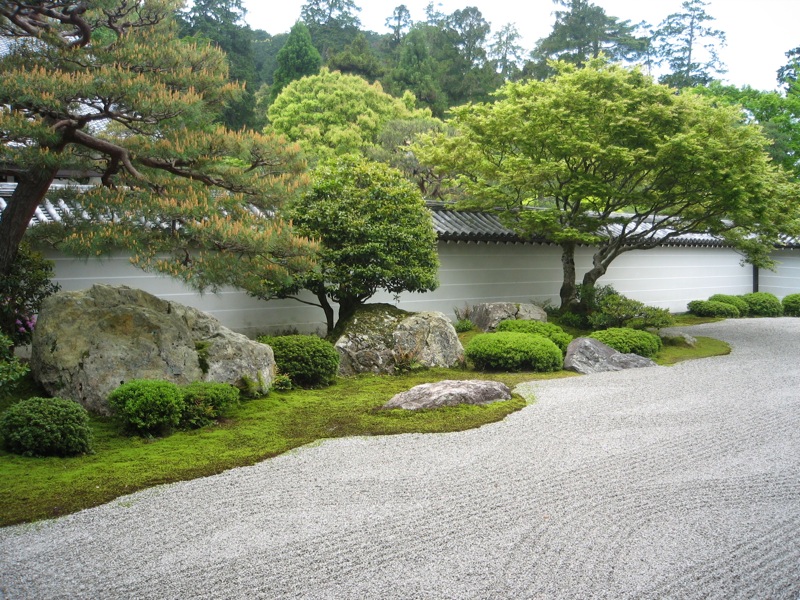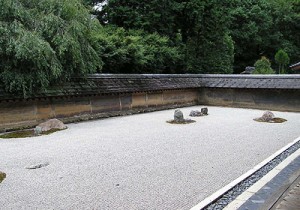The dry landscape garden, or karesansui, is a symbolic element in Zen. Not only is it utterly simple, which is very common to Zen, but it is also very planned and structured. A possible catalyst for enlightenment, the Zen garden is used as a place for contemplation, deep thought, and zazen. It is considered to be the serenity in a chaotic world and can release one from such chaos. The garden is much like the concept of wu or mu, the notion of a void beyond all form and color. Some gardens are walked through and others are to only be looked at, but all are carefully planned and maintained environments; if a leaf were to fall, it would be removed in order to maintain the designer’s plan.
The primary intention of any Zen garden is its ability to guide one to satori, or enlightenment. One could simply gaze at the garden,  contemplating its meaning while meditating in order to reach satori. For example, the dry landscape garden at Ryoanji has various interpretations of its meaning. Some say that the pebbles represent the rocky waves of the ocean and the rocks are the islands of Japan. Others interpret the boulders to represent mountains, and the pebbles the clouds through which the peaks stick out. One could find many meanings for the rock garden, and in doing so could be in deep contemplation. The student who maintains the garden, raking the pebbles into a distinct pattern, would also be on the path to satori. The constant repetitive motions would free one’s mind of the mundane in order to contemplate that which is important, much like a koan. Whoever gazes upon the garden, despite culture or religion, can appreciate its beautiful simplicity and Japanese aesthetic. It could be said that the simplicity and sense of limitless space one sees in a garden is much like that of the Zen practitioner’s mind; it, too, it limitless and has no restrictions.
contemplating its meaning while meditating in order to reach satori. For example, the dry landscape garden at Ryoanji has various interpretations of its meaning. Some say that the pebbles represent the rocky waves of the ocean and the rocks are the islands of Japan. Others interpret the boulders to represent mountains, and the pebbles the clouds through which the peaks stick out. One could find many meanings for the rock garden, and in doing so could be in deep contemplation. The student who maintains the garden, raking the pebbles into a distinct pattern, would also be on the path to satori. The constant repetitive motions would free one’s mind of the mundane in order to contemplate that which is important, much like a koan. Whoever gazes upon the garden, despite culture or religion, can appreciate its beautiful simplicity and Japanese aesthetic. It could be said that the simplicity and sense of limitless space one sees in a garden is much like that of the Zen practitioner’s mind; it, too, it limitless and has no restrictions.
Another aspect of the Zen garden is its relationship with the natural, unplanned surrounding landscape and the planned architecture. The gardens are very planned and contain a maximum reduction of elements for the greatest possible impact. They interact with the natural surroundings and architecture and play off each other. This concept is known as borrowed landscape scenery or shakkei. The mountains common to Japan were a beautiful backdrop for the Zen gardens. In the case of the mossy hills garden at Tofukuji, there is great interaction between the abbot’s quarters, or hojo, and the mossy hills. The hills look quite natural as they fit perfectly next to the hojo, but they are not natural and were put there intentionally to interact with the structure. Any other landscape features, such as trees, would interact with the garden, providing even more elements for one to contemplate.
Buddha nature is also a vital aspect to Zen, as well as the Zen garden. The Zen practitioner believes that there is Buddha nature in all things. Therefore, every element in the garden contains Buddha nature, including the rocks, moss, pebbles, and any other object one would see. This concept is also seen in all Zen artwork; the artist shows that even the seemingly mundane object, such as bamboo or a bird, possesses the Buddha within them.
One of the most famous Zen gardens is located at the Ryoanji Monastery, one of the Five Mountains, in Kyoto, Japan. This is the epitome of all  that is Zen. It consists of fifteen rocks of varying size and shape, all lying atop beds of moss. The pebbles are carefully raked into a simple, very planned pattern. This is seemingly random and casual in design, but it is far from random. The designer carefully planned this garden so that from every angle at which one observes the garden, only fourteen of the fifteen rocks can be seen. This is a truly amazing design and has all the elements of Zen, including the very carefully planned design.
that is Zen. It consists of fifteen rocks of varying size and shape, all lying atop beds of moss. The pebbles are carefully raked into a simple, very planned pattern. This is seemingly random and casual in design, but it is far from random. The designer carefully planned this garden so that from every angle at which one observes the garden, only fourteen of the fifteen rocks can be seen. This is a truly amazing design and has all the elements of Zen, including the very carefully planned design.
It is rectangular in shape in order to maintain the simplicity expected. The rocks are sporadically laid out, in a very asymmetrical pattern. They have also been chiseled, in order to reach the ideal shape that best compliments the design. There are pebbles that would be raked daily by a Zen student on the path to satori, clearing their mind of the mundane. In addition to the garden itself, there are surrounding elements that interact and have a relationship with the design. This is also something that one could contemplate and try to interpret its meaning or symbolism. Any garden can have a million interpretations, depending on the viewer. It is also a place in which anyone could meditate and try to reach enlightenment.
The Zen garden is seemingly simple in its appearance, but in actuality there is nothing simple about a Zen garden when one really looks at it. The karesansui is meticulously planned by a Zen practitioner and has infinite potential. Not only is it a place for viewing or walking through in order to calm oneself, but it is actually a catalyst for enlightenment in many ways. The garden also has infinite meaning and can be interpreted in any way in order to fulfill one’s desires. In the words of Muso Soseki, there are “people for whom the sight of a mountain or of water removes their sleepiness, consoles them in their loneliness, and supports them on their way to truth.” A Zen garden can also accomplish these things that Soseki has described.
